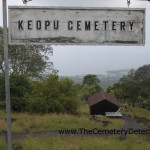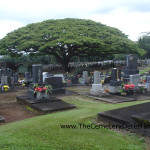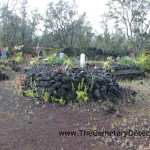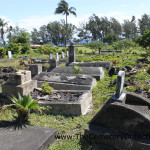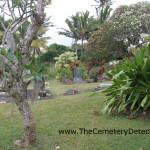When I think of The Big Island of Hawaii I think of the reclaiming forces of volcanic lava flows, tropical plants & fruit, and spectacular views of the Pacific Ocean stretching to the horizon. I also think of cemeteries.
On a recent trip to Hawaii I had three goals; viewing lava flows, snorkeling in the area’s most beautiful water, and visiting the island’s cemeteries. Hawaii exceeded my expectations with fresh lava & clear waters and though I might have missed 1 or 2 uncharted cemeteries, I was able to visit all the cemeteries I had researched before my trip. Using USGS charts, Google Earth, and GPS data sets I had my research all planned out.
I visited 30 cemeteries on the big island. Below are my top 5 favorites.
#1 Keopu Cemetery
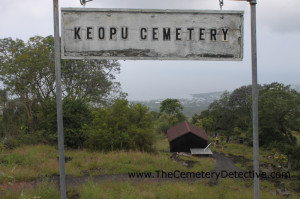
With binoculars in hand, visitors to Keopu Cemetery can faintly see Kona’s high-rise hotels and largely developed tourist beaches. However, at more than 2.5 miles distance and 1450′ feet of increased elevation Keopu’s rugged, lava strewn landscape seems worlds apart from Kona’s main strip.
If not for a wooden sign, Keopu would be hidden from roadway view as its driveway drops off suddenly placing its grave markers and utility building out-of-site for drivers.
Gravesites are plentiful in Keopu. Smooth polished grave markers dramatically contrast the rough Aa lava remnants that surround or encompass each gravesite. Families have attempted to define some grave sites with borders of concrete or cinder blocks. Still, other gravesites are completely obscured by lava chunks.
Flowers in tea cups are placed near grave markers as the occasional overturned saucer or plate can be seen on a few tombstones. Vegetation is sparse with colonizing grasses, ferns, and trees beginning to take over the landscape. However, since roots are shallow and easily disrupted, volunteer workers in the cemetery find it easy to keep the cemetery from being overgrown.
Keopu’s driveway is paved but it is narrow and steep. Visitors with good hiking ability will enjoy parking at the top of the cemetery and traversing the driveway by foot so they can easily visit each interesting grave site.
#2 Niulii Cemetery
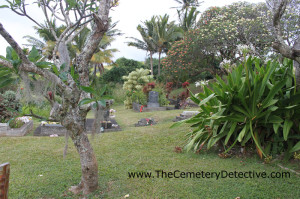
On the northeast quadrant of Hawaii, tucked in amongst the tight knit community of Makapala, off the Akoni Pule Highway lies Niulii cemetery. A large glass enclosed sign bears the names and birth/death dates of the 43 people interred here. Bordered by palm trees and delicately landscaped, Niulii’s carefully manicured lawn follows the contours of the steep and undulating ground.
The earliest burial date is 1915 and the cemetery seems to be currently active with burials as late as 2008.
Niulii Cemetery serves the Makapala community. Residents care greatly for the cemetery and keep its grave markers decorated with traditional flowers and leis. Niulii presents an aire of welcome as a handmade bench welcomes visitors to sit and rest after wandering through the rows
of gravesites.
#3 Alae Cemetery
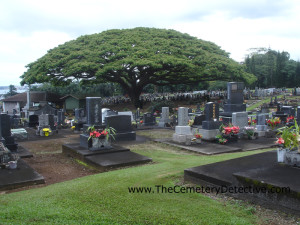
Dominated by the 160′ canopy of a single Monkeypod Tree (Samenea Saman) grave sites in the middle section of Alae Cemetery bask in shade while the cemetery’s other grave sites are fully exposed to sun, wind, and rain. Just 5 miles outside of Hilo, on the island’s east coast, Alae Cemetery offers a plush, grass filled landscape. A paved roadway within the cemetery allows easy access to most gravesites.
Predominantly of Japanese culture, the grave sites within Alae Cemetery are traditionally decorated. Artificial floral and other adornments to the graves are discouraged though there are occasional placements of tea cups, toy cars, and Japanese statues. Arrangements of anthurium add plenty of red splashes to the cemetery and gilded lettering offset many inscriptions on the otherwise dark colored tombstones.
Alae Cemetery is an easy 10 minute drive from Hilo. It is a private cemetery and observes structured hours of operation.
#4 Laupahoehoe Cemetery
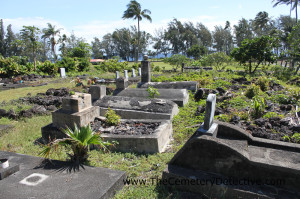
Tsunamis are common in Hawaii but the events of April 1, 1946 were not common or expected.
A Tsunami that originated from an Aleutian Islands earthquake came ashore at Laupahoehoe Harbor while school was in session. As the local school house was overcome by the raging waters, screaming children and frightened teachers were ripped from their desks and washed out to sea.24 people ranging in age from 3 months to 35 years lost their lives in the Tsunami. Many people were rescued by dedicated residents and rescue personnel. One lady survived by clinging to and floating on a door that was torn from a teacher’s cottage.
Laupahoehoe Cemetery is adjacent to the harbor and serves the community. Surrounded by a bordering fence of lava chunks that is overgrown with vegetation, the burying ground contains victims and survivors of the 1946 Tsunami as well as other residents. Grave sites contain flush graves with traditional tombstones yet there is a row of raised burial tombs with rounded crypt covers.
It is easy to become lost in your thoughts while wandering Laupahoehoe Cemetery with the sound of mighty Pacific Ocean waves crashing in the background.
#5 Cemetery Near Kalapana
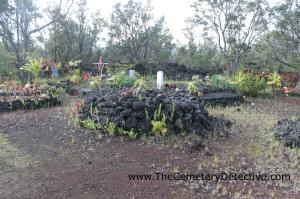
In 1986 a Kilauea lava flow greatly affected the community of Kalapana. That lava flow as well as subsequent lava activity buried Kalapana as much as 50 feet deep with lava. Satellite imagery of this area of Hawaii shows definitive lines of demarcation between ancient and recent lava flows.
Along the Kapoho-Kalapana road those lines of demarcation are evident. Ground coloration, foliage age, and abundance of structures can change within a matter of feet. One moment you might be driving on land that is generations old and the next moment you can be driving over a lava flow that happened within recent memory. Trees get destroyed, structures burn down, and cemeteries become covered. There are cemeteries in this area that are undocumented and remain covered by lava.
One cemetery on the Kapoho-Kalapana road that has been covered by lava is barely visible. Though family members of those buried have worked diligently to remove lava from burial sites, much of the cemetery is invisible due to lava and subsequent pioneering vegetation. Pioneer plants are those plants which grow within cracks and indentations of recent lava flows. Birds, other animals, and wind deposit seeds. If a seed takes root, it is considered a pioneer plant.
This cemetery near Kalapana stands on its own merits and it also is on this list of cemeteries to honor all those other cemeteries that have been erased from our history books due to lava flows and other natural events.
Large portions of The Big Island’s surface and 90% of Kilauea’s surface is less than 1000 years old. The island is in constant motion through geological plate tectonics. A Hawaiian geologist told me “you can spit on ground today that wasn’t there yesterday.” Cemetery documentation through words, images, and GPS coordinates is as important in Hawaii as anywhere else in the world. We never know when the next lava flow will completely obliterate a cemetery. Through documentation work of myself and many interested people the history of these cemeteries can be shared and retained despite natures reclaiming forces.
– The Cemetery Detective

